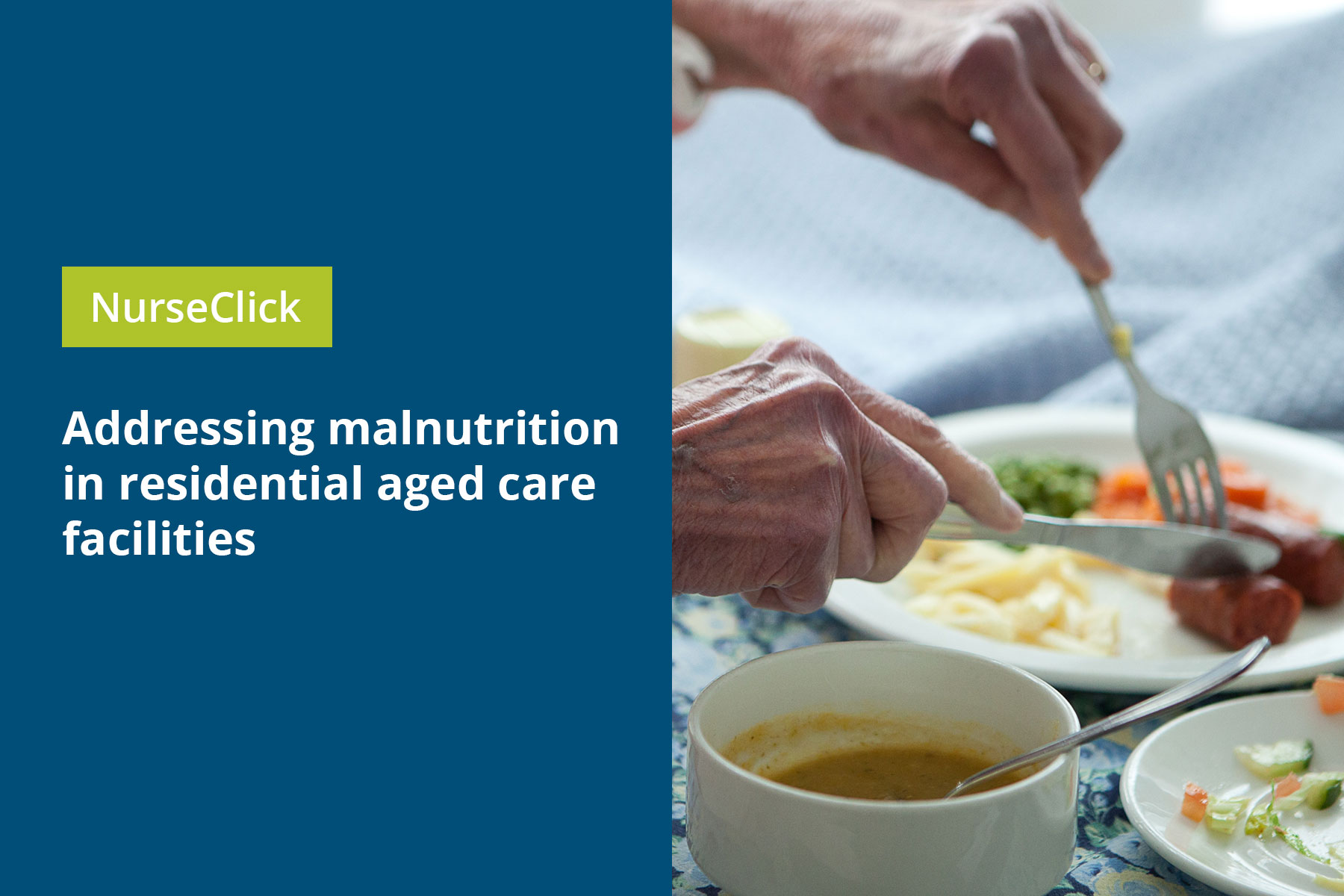A nutritional study conducted by Monash and Griffith Universities has revealed the alarming extent of malnourishment in residential aged care facilities (RACFs). The study reports that over 40% of residents were categorised as malnourished, while 6% were characterised as severely malnourished (O’Shea et al., 2024). The federal government currently estimates the cost of malnutrition in RACFs at approximately $9 billion a year. Malnutrition is associated with poorer overall health, increased hospitalisation rates, higher rates of falls and fractures, slower wound healing, higher infection risk, and accelerated mortality.
The 2021 Royal Commission into Aged Care Quality and Safety report states that the residential aged care sector has “failed to meet the nutritional needs of people for whom they care”. The Commission specifically identified improving nutrition as a priority area for immediate attention (Aged Health, 2024).
Factors contributing to malnutrition
There are several contributing factors that can lead to malnutrition; these include physical changes related to ageing, medical factors, lifestyle, and social and psychological factors.
However, elderly people living in RACFs have an increased risk of developing malnutrition from several factors specific to the environment. Elderly residents are slower at eating yet have limited time to finish meals; they are often rushed through meals and have limited supervision or support with feeding. Without support, elderly residents struggle to reach their food, use cutlery, or open packages and often give up in frustration. There is also limited provision for religious, cultural, or dietary preferences. Residents lack choice when it comes to meals; for some, the food presented may evoke unpleasant sights and smells (Çevik Varol, 2023 & Fávaro-Moreira et al., 2016).
Consequences of malnutrition
Malnutrition in the elderly is a challenging health concern associated with not only increased mortality and morbidity but also with physical decline, which has wide-ranging acute implications for activities of daily living and quality of life in general (Corcoran et al. 2019 & Norman et al. 2021). The consequences of malnutrition in the elderly are not always obvious; apart from the noticeable physical effects, such as decreased muscle function, it can also negatively impact the body, mental function, and immune system.
Of particular concern is the impact of malnutrition on involuntary weight loss, which is associated with the loss of skeletal muscle mass. This increases the risk of developing sarcopenia, a phenomenon that is characterised by the loss of both muscle mass as well as muscle strength and function. Sarcopenia is a significant risk factor for developing physical frailty, which includes fatigue, weakness, slow gait speed and low physical activity (Bardon et al. 2021 & Norman et al. 2021).
Malnutrition delays the normal processes that allow progression through stages of wound healing, particularly a protein deficit, which impairs the repair and maintenance of body tissue and can result in chronic nonhealing wounds. Malnutrition also negatively impacts the immune system of the elderly, leading to an increased risk of developing sepsis (Corcoran et al. & Dent et al., 2023).
Addressing the problem
Nurses play a crucial role in preventing and managing malnutrition in the elderly, both in RACFs and the community. Their expertise and close interaction with the elderly in these settings position them to address the problem at the coal face.
There are several government initiatives that are intent on addressing the problem. The National Aged Care Mandatory Quality Indicator Program (QI Program) includes 11 quality indicators across care areas that can affect the health and wellbeing of residents living in RACFs. Quality indicator 3 refers to unplanned weight loss (Australian Government, 2024).
In addition, The National Safety and Quality Health Service (NSQHS) Standard 5 – Comprehensive Care describes the integrated screening, assessment, and risk identification processes for developing an individualised care plan to prevent and minimise the risks of harm in identified areas. Nutrition and hydration are included as areas of concern regarding the risk of harm (ACSQHC, 2021).
Nurses play an important role in several key aspects of these programs. Nurses are involved in risk assessment, including identifying risk factors such as frailty and identifying elderly people with high nutritional needs, including those who are nutritionally at risk. Nurses are also integral in developing, delivering, and monitoring prevention plans (ACSQHC, 2021).
Nurses also have an important role in treating malnutrition in the elderly. Nurses are involved in identifying and treating the underlying cause, correcting nutritional deficits, restoring recommended caloric intake, and providing dietary supplementation where required.
Want to learn more?
To learn more about malnutrition in the elderly and what nurses can do to make a difference, The Australian College of Nursing (ACN) has developed an online learning module, Managing Malnutrition in the Elderly, available free of charge for ACN members. This module explores factors that contribute to malnutrition and the consequences of malnutrition in the elderly. The module also explains how to apply and interpret appropriate malnutrition screening tools during an assessment of the elderly and how to employ strategies to prevent and/or manage malnutrition in the elderly.
ACN has many courses specific to Aged Care Nursing, including the Graduate Certificate in Aged Care. To learn more about the graduate certificate and other courses, please visit here.
Author: Judith Smith
Director of Professional Development (ACN)
Judith Smith is the Director of Professional Development at the Australian College of Nursing. In addition to being the primary figure overseeing the Aged Care Transition to Practice Program, Judith leads several other national nursing initiatives through ACN. Her passion lies in enhancing the capacity of the nursing workforce by actively engaging nurses across all levels. Judith’s approach involves challenging and empowering nurses to achieve professional and personal growth, enabling them to emerge as leaders in their field. This commitment is evident in her successful career, which has spanned nursing education and clinical, tertiary, and corporate settings.
Beyond her role, Judith has contributed nationally and internationally to curriculum design. She actively participates in state and national working parties and advisory groups to enhance service performance and patient outcomes. Judith’s influence extends to her contributions to various publications, including peer-reviewed journals and as a chapter author in professional textbooks.

References
Aged Health. (2024). 40% of aged care residents malnourished, study finds. E-news. Available at www.agedhealth.com.au
Australian Commission on Safety and Quality in Health Care. (2021). National safety and quality health service standards (2nd ed.). Sydney: ACSQHC.
Australian Government (2024). The National Aged Care Mandatory Quality Indicator Program (QI Program), Department of Health and Aged Care. https://www.health.gov.au/our-work/qi-program
Bardon, L. A., Corish, C. A., Lane, M., et al. (2021). Ageing rate of older adults affects the factors associated with, and the determinants of malnutrition in the community: A systematic review and narrative synthesis. BMC Geriatrics, 21(676). https://doi.org/10.1186/s12877-021-02583-2
Çevik Varol, A. (2023). Malnutrition in the elderly: A recent update. IntechOpen. https://doi.org/10.5772/intechopen.104430
Corcoran, C., Murphy, C., Culligan, E. P., Walton, J., & Sleator, R. D. (2019). Malnutrition in the elderly. Science Progress, 102(2), 171-180. https://doi.org/10.1177/0036850419854290
Dent, E., Wright, O. R. L., Woo, J., & Hoogendijk, E. O. (2023). Malnutrition in older adults. The Lancet, 401(10380), 951-966. https://doi.org/10.1016/S0140-6736(22)02612-5
Dietitians Association of Australia. (2019). Is malnutrition an issue in Australia? Retrieved from https://daa.asn.au/smart-eating-for-you/smart-eating-fast-facts/medical/is-malnutrition-an-issue-in-australia
Ettema, C., Huisman-de Waal, R., Bell, G., Verbrugge, J., Schoonhoven, R., et al. (2020). Interventions to prevent and treat malnutrition in older adults to be carried out by nurses: A systematic review. Journal of Clinical Nursing, 29(11-12), 1883–1902. https://doi.org/10.1111/jocn.15153
Fávaro-Moreira, N. C., Krausch-Hofmann, S., Matthys, C., Vereecken, C., Vanhauwaert, E., Declercq, A., Bekkering, G. E., & Duyck, J. (2016). Risk factors for malnutrition in older adults: A systematic review of the literature based on longitudinal data. Advances in Nutrition, 7(3), 507-522. https://doi.org/10.3945/an.115.011254
Ferrari Bravo, M., et al. (2018). Assessment of malnutrition in community-dwelling elderly people: Cooperation among general practitioners and public health. Iranian Journal of Public Health, 47(5), 633-640.
Norman, K., Hass, U., & Pirlich, M. (2021). Malnutrition in older adults: Recent advances and remaining challenges. Nutrients, 13(2764). https://doi.org/10.3390/nu13082764
O’Shea, M.-C., Bauer, J., Barrett, C., Corones-Watkins, K., Kellett, U., Maloney, S., Williams, L. T., Osadnik, C., & Foo, J. (2024). Malnutrition prevalence in Australian residential aged care facilities: A cross-sectional study. Healthcare, 12(13), 1296. https://doi.org/10.3390/healthcare12131296
Ten Cate, D., Ettema, R. G. A., Huisman-de Waal, G., Bell, J. J., Verbrugge, R., Schoonhoven, L., & Schuurmans, M. J.; Basic Care Revisited Group (BCR). (2020). Interventions to prevent and treat malnutrition in older adults to be carried out by nurses: A systematic review. Journal of Clinical Nursing, 29(11-12), 1883-1902. https://doi.org/10.1111/jocn.15153





